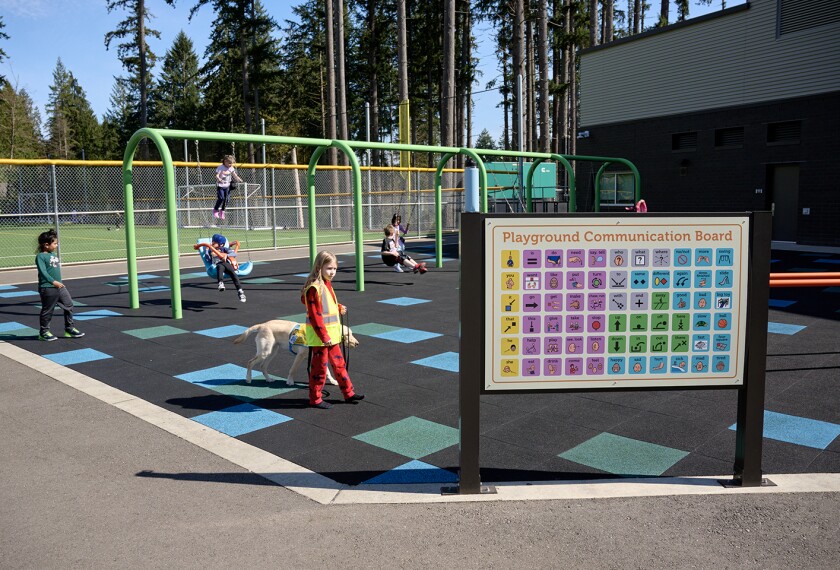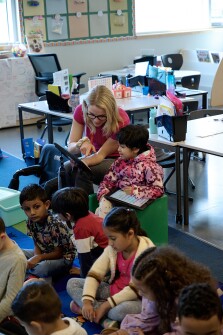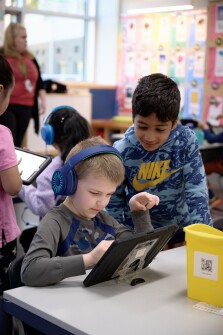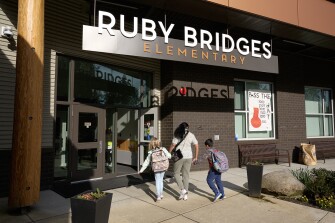This article was written by Caitlynn Peetz on April 14, 2024 and published by EdWeek.

When students walk into Ruby Bridges Elementary School to start their day, nobody is pulled aside or separated from their peers to receive special instruction.
There’s no need.
Everything at the school—from the seating to staffing—was designed to ensure students with disabilities can learn alongside their peers, transforming what has traditionally been a model of exclusion in U.S. public schools to one of inclusion and belonging.
Ruby Bridges opened in 2020 and the staff at the Woodinville, Wash., school have spent the past four years creating an environment that conveys to every child who walks in: “We thought of you when we made this place, and today could not happen if you weren’t a part of it,” said Principal Cathi Davis.
“So obviously we don’t want you to leave the classroom to do something else because, then, how could science [class] be the same?” she said. “It’s this idea for kids that they are so important that something would be missing in a unique way if they weren’t there.”
The K-5 elementary school about 20 miles northeast of Seattle serves just under 500 students. It’s one of 16 schools in Washington state that partner with the Haring Center for Inclusive Education at University of Washington with the goal of demonstrating that all students benefit when schools are deliberately crafted with the needs of students with disabilities in mind.
There’s no singling out students with special needs
At Ruby Bridges, staff have structured everything around the idea of keeping students with special needs in mainstream classrooms as much as possible.
Instead of pulling students with complex needs into separate classrooms for lessons specially tailored to their needs, they head to class with their peers.
There, everyone has access to supports traditionally outlined in students’ IEPs or 504 plans, like the ability to take breaks when feeling overwhelmed. Students may choose to wear lanyards around their necks with cards that display words and pictures so they can communicate with classmates who do not speak. Some students may choose to learn in a group with the teacher, while others might work independently on a tablet with headphones on.

Many students at Ruby Bridges—where about 16 percent of students are identified as having disabilities—can’t communicate verbally, so every student has access to assistive communication devices, like picture boards or computers that synthesize speech from text.
“Our responsibility is to have a school with classrooms that are ready for kids, not a school where kids are forced to be ready for classrooms,” Davis said.
In practice, this means that students with disabilities spend 80 to 100 percent of their academic time with grade-level peers.
There are resource rooms students can use when they need a break or for a specific, one-on-one activity with a paraprofessional, but they are all “flex spaces” with no set schedule. They are open to everyone, Davis said.
Instead of pulling students out of class for extra help with phonics or other skills, paraprofessionals come to them. The same goes for English learners.
And rather than having a designated paraprofessional assigned to each student who needs that level of extra support, paraprofessionals work with different students all the time. In the morning, they could be supporting an advanced math group and working with a different group on phonics in the afternoon.
What’s more, small group and intervention time is built into the calendar for everyone so that when paraprofessionals come in to work with specific students, nobody is singled out—everybody is working on something, and nobody is missing a whole-class lesson.
The setup reduces stigma that students may feel when they’re singled out for extra help, Davis said.
“You see lots of adults everywhere, and it’s because no one’s working separately behind closed doors, and all of the adults in the school are communicating and collaborating to support all students,” Davis said. “Kids pick up on if one para only helps kids who are really struggling with one thing, so there’s a very specific effort to make a heterogeneous mix.”
Belonging can be ‘elusive for students with disabilities’
There is increasing evidence that work to create a full sense of belonging for students with disabilities, like what’s happening at Ruby Bridges, benefits all students’ achievement and social skills.
Students with special needs perform better when they spend significantly more time in mainstream classrooms than in special education rooms, according to researchers who, writing in the Journal of Special Education in 2022, found that the students who spent more time in mainstream classrooms were exposed to more rigorous coursework. Researchers have also found that the inclusion of students with disabilities in general education classrooms has resulted in students without disabilities learning how to respect others and gaining awareness and skills to help others. Several studies over the years examining these more inclusive practices have found either neutral or positive effects on all students’ performance in core subjects like math and reading.
“Belonging matters for kids with disabilities in the same ways it matters for any other student in our schools. The difference is that belonging can be much more elusive for students with disabilities,” said Erik Carter, the executive director of the Baylor Center for Developmental Disabilities at Baylor University who has conducted extensive research on the topic.

Only including students with disabilities in activities outside of class, such as recess and lunch—or including them in classes that aren’t set up to accommodate their needs—isn’t enough to foster a sense of real belonging and camaraderie, Davis said. The work has to be intentional, and it’s often uncomfortable because it requires challenging the setup that has been the status quo for decades in many places.
The payoff is incalculable, though, Davis said.
“The parents and families of students identified as having a disability are constantly going to meetings, being told how different their children are from an arbitrary set of norms and all of the services they need, that often mean having less community,” Davis said. “But we have a responsibility to create spaces where we don’t make deep, impactful lifelong decisions about the lives our students will have before they even have an opportunity to make decisions for themselves.”
Fostering belonging can give students ‘their dignity back’
The partnership between the University of Washington and schools including Ruby Bridges was made possible by a grant to support more inclusionary practices in the state—particularly to reach that threshold where students with disabilities spend at least 80 percent of their time in general education classrooms, a goal driven by federal policy that requires students be taught in the “least restrictive environment” appropriate for them. About two-thirds of students with disabilities met the goal in the fall of 2020, according to the National Center of Education Statistics, markedly higher than the 32 percent who did in 1989.
But Washington state has struggled to keep pace, with about 60 percent of students with disabilities spending 80 percent or more of their time with their peers in 2020. As of 2018, a report cited by state officials ranked Washington 44th out of 50 in inclusionary practices, which prompted state lawmakers to earmark $25 million to spur improvements through professional development statewide and more targeted support in pilot schools.
Ruby Bridges is considered a “demonstration site” for the partnership with the university, opening its doors over the past two years to more than 350 visitors and observers who want to learn about best practices in teaching students in the least restrictive learning environment.
The school models its work around the “10 dimensions of belonging” developed by Carter at Baylor, which begin with allowing students with disabilities to be present, then invited, and ultimately accepted, supported, befriended, needed, and loved.
“Belonging is more than just being included or present in a space,” Carter said. “People want to experience belonging, and that’s more than merely a location of classrooms or participation in clubs—it’s about what students experience and the relationships that develop in those places.”
Monroe High School, located about 30 miles northeast of Seattle, is also part of the partnership with the University of Washington, working to foster belonging in school for older students with disabilities.
Oftentimes, that means they arrive at the high school having spent their entire academic careers receiving much of their instruction apart from their peers in general education, said Principal Brett Wille. So, when students with disabilities spend most of their time in a mainstream classroom, they “get their dignity back,” he said.
“When you have a kid in an exclusionary classroom in the corner of a school building doing 1st grade math problems, that doesn’t give them a lot of hope or dignity,” Wille said. “But when you put these students with their peers, you’re telling them you value them and you believe in them. Kids pick up on that.”
Another upside: Employee retention
The model requires a shift in adult mindsets: Educators aren’t responsible only for their classroom or a specific group of assigned students. Instead, everybody is responsible for every student.
It can be a daunting perspective, Davis said, but once it becomes ingrained in the school culture, it can prove a rewarding environment for staff with an added benefit of less staff turnover, particularly among paraprofessionals who can be difficult to retain.

In fact, paraprofessionals who have completed teaching licensure programs have stayed on staff at Ruby Bridges waiting for a teaching position to open up, rather than leaving for open teaching jobs elsewhere.
“When you shift in those ways, you create deeper connections for students and staff, too, and when you’re set up around real belonging, then adults feel like something would be missing if they were gone, too,” Davis said. “You create systems that are less isolated in every way.”